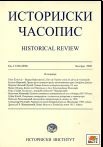Лесковачки вакуфи у периоду од османског освајања до краја XVI века
Leskovac Vakufs during the Ottoman Conquest until the End of the 16th Century
Author(s): Dragana AmedoskiSubject(s): History
Published by: Istorijski institut, Beograd
Keywords: Leskovac; vakuf; Kruševac sanjak; Ottoman Empire; 16th century; mosque; mesjid; zaviya; musala; maqtab
Summary/Abstract: During the 16th century, Leskovac was a small town with pronounced Muslim majority, and, with the aid of vakuf, became a settlement with all the Oriental-Islamic characteristics. The first phase in the development of Leskovac as an Ottoman settlement, through vakuf, covers early period of the Ottoman rule, and ends immediately following the conquest, and is marked by the building of the mosque, hammam, and mesjid. In the following period, Leskovac acquired another mesjid, maqtab, caravan saray and bridge, all of which were the part of the vakuf of Mevlana Muhiyudeen, son of Iskander. This was the most prosperous Leskovac vakuf, which particularly influenced that Leskovac acquired an Oriental look. Between 1536 and 1570, there was a sudden increase of the Muslim population, even the real development of the foundations. During this period, another three mesjids, one zaviya, another mosque, as well as the hammam in the Perate village were built. The last phase is characterized by the slow decrease in population, so in the following few decades only a single mosque and a maqtab were built.
Journal: Историјски часопис
- Issue Year: 2008
- Issue No: 57
- Page Range: 137-150
- Page Count: 14
- Language: Serbian

